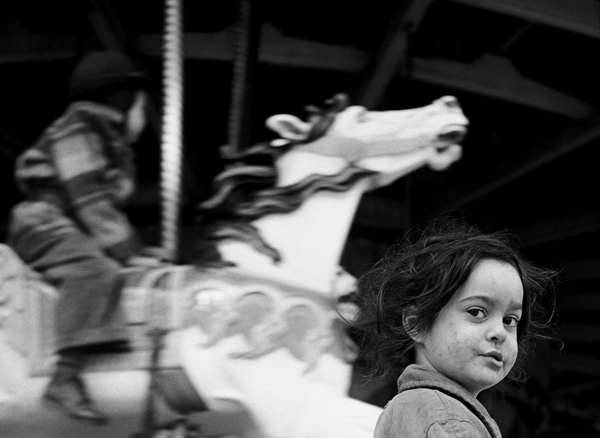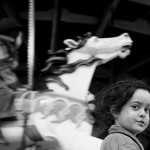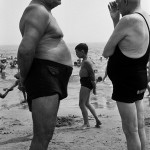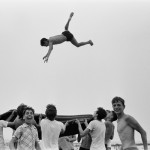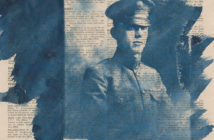"It’s a nickel a question," he joked. At that point, I suppose I already owed Harold Feinstein five cents, since I had just asked if I could ask him a question. Feinstein, of course, is a street photographer whose meteoric rise to fame began when he was just 15 years of age, and Edward Steichen took a liking to his work, acquiring it for MoMA’s collections. A member of Berenice Abbott’s The Photo League throughout the 1940s, Feinstein rubbed elbows with W. Eugene Smith, Weegee, and Robert Frank, among other luminaries. He is, to put it simply, legendary. But now in his early 80s, it’s clear that his iconic status hasn’t gone to Feinstein’s head. Never one to rest on his laurels, Feinstein has photographed for well over six decades. He maintains a good-natured sense of humor and an approachable attitude, especially when wearing a lei. I have it on good authority that you can ask him "as many questions as you like."
The opening for Harold Feinstein: A Coney Island Summer, on view now at Panopticon Gallery through September 10, was in keeping with the artist’s temperament. Decor and convention were thrown overboard, and the gallery was transformed into a luau, replete with monkey pool floats dangling from the sconces and hula dancer cutouts on the double doors. Feinstein himself has a gentle, but all embracing love for life. It’s evident in his photos, time capsules of the joys of youth spent like spare change, when change was plentiful, at the carnival and beach. The crowd was eclectic. Fellow Panopticon artist Eileen Clynes was in attendance, her bangs rolled and hair done up in a soft pompadour, sporting a knee-length dress and high heels that revealed extensive tattoos up her arms and legs. She not only captured the aesthetic of the 1950s perfectly, appearing to have stepped out of one of Feinstein’s photographs, but she shared with me the artist’s first words when he saw her there: "Eileen, I’m so glad to be alive!" Feinstein is recovering from health complications, but he is as spirited and lively as ever. The sentiment can be felt in all of his work, and that’s saying something, as Feinstein does not shy away from the grimmer or grittier facts of life.
A Coney Island Summer contains those multitudes. Feinstein’s approach is expansive. The carnival is coupled with the lunch counter and beauty parlor, boisterous play with the workaday grind, somber men in business suits on the boardwalk (the kind who look like they didn’t come to have fun, if you know what I mean) with blissful teenagers in young love stretched out across each other on the shore. His eye takes in everything, but especially that which his contemporary, beat poet Lawrence Ferlinghetti would dub "A Coney Island of the mind, a circus of the soul." "It was the place to go," remarked Feinstein. His father would give him forty cents and off he would go on the three-cent trolley car, destination Coney Island. Feinstein spent his allowance within minutes, making it up by drawing portraits for 16 cents each along the boardwalk. Coney Island was an indelible part of his childhood, as ingrained in his memories as in the national consciousness. It’s Americana writ large.
Since then, Feinstein has mastered the momentary portrait in the crowd or through the window. Often the subject is looking over his or her shoulder back at the photographer, a glance that becomes memorialized in gelatin silver. But his portraits of children are surprisingly serious, evincing a kind of understanding and self-awareness that we too often do not realize they possess. His Gypsy Girl at the Carousal, Coney Island, 1949 shows us a young girl casting a precocious glance back at someone in the crowd as she waits at, but does not ride, the merry-go-round. Her eyes are wide and hair unruly, but her expression remains earnest. Over her shoulder, a wild and magical horse looms large, but she does not notice. Young Girl Wearing Fur Coat, NYC, 1954 and Boy in 25¢ Parking Lot, NYC, 1950 are similarly contemplative, dressed to the nines and sitting, like Le Penseur, with chin resting in hand, respectively. They are intense portraits, in keeping with Feinstein's style.
Two Men & a Boy Contemplate, Coney Island, 1950 is amongst my favorites in this regard. The gravity of the elderly men’s conversation in the sand is given levity by their attire, swim trunks that reveal their paunches and seem mismatched with their concerns. But that absurdity, which is enjoyable enough, is put into relief by the passing boy visually sandwiched between the two. Amongst the banter of other children on the shore and splashing in the ocean, the boy walks forward thoughtfully, his arms clasped behind him in a reflection of the old man to his left. That they both don the same high-waisted shorts on ample potbellies is a sure sign of the photographer’s good humor. It’s a perfect moment, the kind that street photographers appreciate and sometimes capture. Feinstein’s children seem to share adult concerns. But then, he is just as apt to photograph adults acting like kids on the subway or The Cyclone!
The curatorial decision to pair Feinstein’s Coney Island photographs with his work from the New York City streets heightens these dualities. We see The Whip, 1954, which features two children with wide smiles in cart number 4 of the eponymous ride as it whirls in motion, but this is contrasted with Woman Stepping from Car on Surf Avenue, NYC, 1946, a frumpy and grumpy dowager descending carefully from a parked car in front of an old, weathered building cramped between two new dining establishments. The building, to my eye, seems symbolic. Or take Blanket Toss Beach Play, Coney Island, 1955. A boy is catapulted into the air by his friends, who hold the makeshift blanket trampoline beneath him. Some have turned toward Feinstein, huge grins on their faces. In the exhibition at Panopticon Gallery, a photograph like this is paired with one like Storefront Christ & Children, NYC, 1950. In it, children in disarray, one without a shirt, one without pants, and another without shoes, eat ice cream in front of a stained glass Jesus. They appear to be orphans. Ice cream treats aside, the scene is not joyful.
The entirety of human emotions and lived experiences are captured in Feinstein’s work, but he does not skimp on the details. Look closely at his intense, environmental portraits, and you’ll find hidden treasures. A young man peers through the railings of Parachute Drop Attraction, Coney Island, 1949 at the far corner of the picture. Tattooed Man, Coney Island, 1990 has a proverbial third eye. You could, and should, spend hours with these photos, if for no other reason than the pure pleasure of looking.
Feinstein is an unrivaled street photographer, but these days, street photography is not in vogue. With few exceptions, academics seem to have forgotten the compositional skill and quick technical maneuvers, the sociopolitical understanding and artistic intuition, that go into making a successful street photograph. They, especially, should see this exhibition. Because this is what their work is missing. Feinstein is in the good company of a long tradition of street photographers, and he is among the best. But, that being said, it’s not all street photography in A Coney Island Summer. I just had to ask gallery director Jason Landry about the still life My Mother’s Curtains, Brooklyn, NY, 1946 and what seems to be a portrait of a bird, Bird in Hand, 1955. Their inclusion in the exhibition, I knew, had to have been the result of an interesting curatorial decision.
And it was. As it turns out, Feinstein had wanted to include the former for sentimental reasons, as if he were not already a sweetheart enough! My Mother’s Curtains is meaningful for him in a deeply personal way, after all these years. But the latter was Landry’s choice. At first glance, it is so unlike the other photographs, a white bird clasped by soiled hands, its claw juxtaposed with the lower right corner of the frame, that I had to wonder. But the bird’s eye is as passionate as any of Feinstein’s other portraits. It wants to fly, clearly, but is prevented from doing so.
Bird in Hand is symbolic. It was among the first of Feinstein’s photographs that Landry had ever seen, and remains one of his favorites. So much so that he is at work writing an entire essay about this one photo for an upcoming book. I look forward to reading it. But just as Bird in Hand is a visual symbol, a metaphor, and imbued with multiple subtle meanings worthy of exposition, so too are Harold Feinstein’s street photographs. In that sense, all of his work is the proverbial bird in the hand, inviting us to enjoy the wonders of the most near and dear, the most familiar or homespun, of places to go.
- Harold Feinstein , Gypsy Girl at the Carousal, Coney Island, 1949
- Harold Feinstein,Two Men & a Boy Contemplate, Coney Island, 1950
- Harold Feinstein, Blanket Toss Beach Play, Coney Island, 1955

